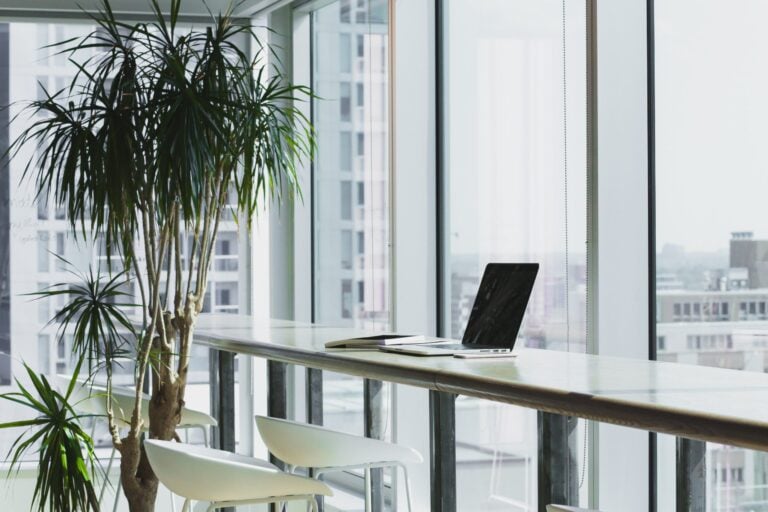The WFH Normal: A Step-by-Step Guide to Making a Sustainable Home Office
 During a global pandemic, almost everyone is making a prudent decision to work from home if their career allows for it. The good news is that this can often be a more sustainable option, cutting out carbon emissions from the traditional commute as well as other derivatives of the typical workday. Disposable coffee cups, excessive amounts of printed paper, and electricity use can all be reduced or eliminated altogether. A recent report from Bloomberg suggests that remote workers are also growing more focused on sustainable living skills. Google found searches for “How to live a sustainable lifestyle” increased by 4,550 percent in the last 3 months leading up to April 20 of this year. To help you promote sustainability in your home office, here’s a guide to get you started on the right foot.
During a global pandemic, almost everyone is making a prudent decision to work from home if their career allows for it. The good news is that this can often be a more sustainable option, cutting out carbon emissions from the traditional commute as well as other derivatives of the typical workday. Disposable coffee cups, excessive amounts of printed paper, and electricity use can all be reduced or eliminated altogether. A recent report from Bloomberg suggests that remote workers are also growing more focused on sustainable living skills. Google found searches for “How to live a sustainable lifestyle” increased by 4,550 percent in the last 3 months leading up to April 20 of this year. To help you promote sustainability in your home office, here’s a guide to get you started on the right foot.
- Figure out what you need
Firstly, your home office requirements vary depending on your specific career. If you already have the tools you need at home, such as a desktop or laptop computer, it’s a matter of figuring out what other electronics, space, and furnishings you need to fulfill your tasks. The Balance recommends investing in some quality essentials, such as an ergonomic office chair to maximize your comfort. You might also need to upgrade your internet service, buy or rent specialized equipment, upgrade your lighting, and purchase additional storage needs. Try your best to ensure that what you buy will stand the test of time.
- Plan out your budget
After figuring out what you need, the next step is determining whether your vision is in line with your budget. For instance if you are permanently making the switch to WFH and own a small-to-medium business then you will want to invest in your workspace. Building a home office from scratch can be a costly venture, with an estimated renovation cost of $30,000 to $50,000 for home office additions for high-income professionals. Making it sustainable through the materials you use could also add to the cost. One way to cover that cost would be through taking out a loan. Marcus outlines how personal loans can go up to $40,000 without additional fees. That would cover the average amount and ensure that the home office meets your specifications. While it may seem like a large investment you can create a relaxing office that is both multipurpose, uses refurbished materials, and will last you for many years. For example, eco-designers John Little and Dusty Gedge built a sustainable home studio using an old shipping container. For those who don’t need or want major renovations it is still important to budget so you don’t overspend on items you don’t need.
- Source your furniture
To make use of what you already have, consider being creative when it comes to finding any storage solutions and furniture you need. The Spruce suggests checking out online marketplaces, garage sales, and thrift stores to find a hidden gem on a budget. In addition, trading furniture with your friends is a great way to find an arrangement that suits both of you. Instead of buying brand-new furniture, sometimes restoring a few hand-me-downs with some paint and sandpaper is a sustainable option. If you do want to purchase new furniture, the ANSI/BIFMA e3 Furniture Sustainability Standard provides some guidelines to help you support eco-friendly furniture manufacturers.
- Maximize energy efficiency
Finally, once your office is set up, taking a look at your energy use is a great way to keep costs down while being kind to the environment. The Natural Resources Defense Council offers a few suggestions on keeping your house cool and lowering your electricity bill. It’s as simple as turning off all energy sources when you leave your home office, and using a combination of the fan and A/C to keep cool. Sealing potential gaps in the wall will prevent cool air from escaping and ensure heated air stays inside, making you more comfortable in the long run. Choosing LED light bulbs over incandescent means that they’ll last for longer and use up to 90 percent less energy to deliver the same results.
While working at home does have its environmental benefits, you can take things a step further by keeping some of these tips in mind. You can even add in some fun extras like a living plant wall to your home office, and we discuss some of the benefits of this in a previous article on ‘6 Reasons Why You Should Have a Living Wall in Your Home or Office’. At the end of the day, making mindful purchases, paying attention to the small things, and spending within your means are all great ways to give you some peace of mind.
Contributed by Katy Pierce


